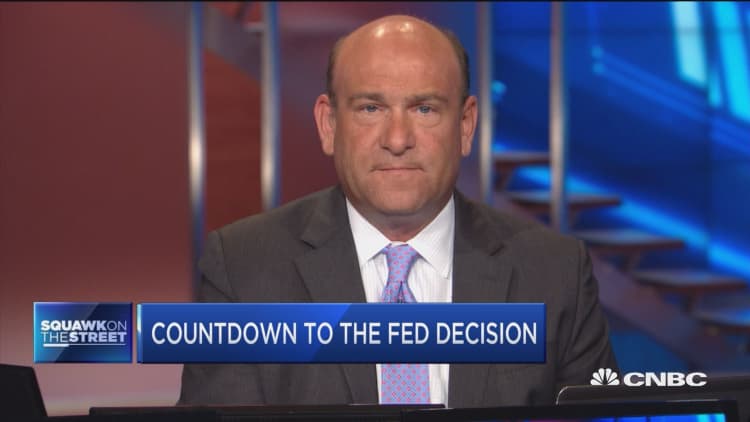
A disappointing drop in retail sales raises more concern about the health of the consumer and reaffirms a widespread view that the Fed will not raise rates next week.
Fed funds futures immediately reflected lower odds — of just 18 percent for a September rate hike, down from 22 percent, after August retail sales were reported to fall by 0.3 percent, according to Jefferies. Odds for a December hike were just above 50 percent, based on fed funds futures.
Core retail sales were down 0.1 percent. That reflects sales, excluding autos, building materials, gasoline and food, and closely correlates to consumption in GDP. Economists had expected a gain of 0.3 percent in core sales, so this number could impact forecasts for third quarter GDP.
"It wasn't a hot one in August this summer for the economy, with consumers pulling back their purchases and factory output sinking. ... We are forced to concede that the economy is sputtering on all cylinders this morning, and the data appear to drive a stake at the heart of our hopes for a Fed rate hike at next week's meeting," wrote Chris Rupkey, chief financial economist at MUFG Union Bank. Rupkey had been one of the few economists who expected a rate hike next week.
There's certainly nothing compelling on the consumer side. We finished up the second quarter with a bang, and we sort of fizzled so far in Q3. That's important.Wade McCarthychief financial economist, Jefferies
Industrial production was also reported at a greater-than-expected decline of 0.4 percent, versus an expected 0.2 percent. That reaffirms weakness seen in other manufacturing data. ISM manufacturing for August actually showed a contraction in manufacturing activity.
But disturbing is that the consumer is now showing more weakness than expected.
"There's certainly nothing compelling on the consumer side. We finished up the second quarter with a bang, and we sort of fizzled so far in Q3. That's important," said Ward McCarthy, chief financial economist at Jefferies. "Consumers are over two-thirds of the economy. Relevant to next week, there's nothing here that would make the Fed raise rates."
The disappointing sales report follows a weaker-than-expected August jobs report, where just 151,000 jobs were created — 30,000 less than expected. The August report on ISM nonmanufacturing activity also showed a startling slowdown in growth in the services sector.
The drop in headline retail sales was the first decline since March. July's initial flat sales reading was revised to an increase of 0.1 percent.
"The weakness in retail sales was scattered across a lot of things. It was driven mostly by motor vehicles but furniture sales were weak, building materials were weak," said McCarthy. "There's no muscle in it ... expect for activity at drinking and eating establishments."
The other key report Thursday was producer prices inflation, which came in flat, as the cost of energy declined. The unchanged reading follows the July drop of 0.4 percent. Economists had expected a gain of 0.1 percent.
McCarthy said that so far, there is no clear connection between consumer activity and the presidential election, though small businesses this week appeared to be more cautious due to politics, according to a survey by the National Federation of Independent Business.
"There were some comments that small businesses were becoming a little more cautious because of the election. I haven't seen anything yet" to show it's affecting consumption, McCarthy said. "I guess our approach to the election is eat, drink and be merry because in November we'll all want to die."
Restaurant and bar sales rose 0.9 percent in August.
A big factor in the decline was a 0.9 percent drop in sales at auto and parts dealers. Nonstore retailers also declined, with a dip of 0.3 percent in sales that include online retailers.
Retail sales were up 1.9 percent from a year earlier, but that pace was slower than July's annual rise of 2.4 percent. Consumer spending had grown at a more than 4 percent pace in the second quarter, double the growth rate of the overall economy.


